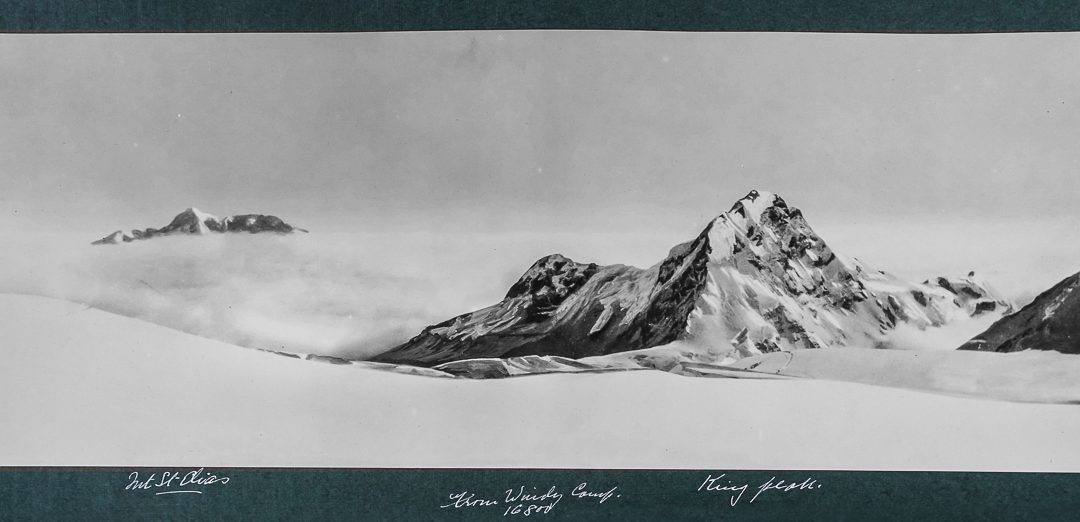Zac’s post was initially published Dec 7, 2019 on the Mount Logan Ice Expedition’s blog under the title “Archives“.

Archives are special places. They are a means to access history directly, as much as that’s possible. Because they’re not an interpretation or intellectualization of past events, but the actual stuff of past events, they bring history closer.
The Archive of the Whyte Museum of the Canadian Rockies is a particularly special place. Located in the heart of Banff, not far from the banks of the Bow River, it holds over 800 archival fonds and collections, representing the mountain cultures and histories of a wider region bounded by the 49th parallel to the south, the Peace River to the north, the Front Ranges in the east, and the Columbias in the west. In September of this year, I paid a visit to the Whyte’s archive because it’s home to the Alpine Club of Canada Fond. And it’s that fond that contains a full set of the lantern slides – over 300 hundred images in all – from Mount Logan’s first ascent, a joint initiative in the mid-1920s between the Alpine Club of Canada and the American Alpine Club.

Lantern slides first originated in the 17th century as hand-painted illustrations on glass that were projected with light as a form of storytelling. It was not until the mid-1800s, a decade after the invention of photography, that photographic lantern slides were introduced, and it wasn’t long until they became widely used in public presentations, in classrooms, in scientific study, and more.
The slide itself consisted of two pieces of glass pressed together, one containing the image and the other placed on top for protection. The two were bound together, using gummed tape. If colour was desired, a slide was carefully hand-painted using transparent oil paints, aniline dyes, or water colours. Paint specifically designed for lantern slides would be produced, but not until the 20th century.

IMAGE Courtesy of the Whyte Museum of the Canadian Rockies, Alpine Club of Canada fonds – Mount Logan Expedition : V14/AC0P/813/180
The hand-painted 1925 Logan slides are as cool as it gets. But I discovered that the actual production of the painted lantern slide, made from the print, which is made from the nitrate negative, incrementally degrades the quality and sharpness of the original image. Wanting the highest quality image available for our repeat-photography project, I was left a bit stumped. Where were the original prints? They weren’t in Banff. Did they still exist? And what about the negatives?
As is sometimes the happy case with archival research projects, serendipity soon struck – but not until a recent trip to Ottawa. The occasion of the Royal Canadian Geographical Society’s recent AGM permitted me the opportunity for a quick stopover at Library and Archives Canada. LAC, as it’s called simply by most, is our federal institution tasked with acquiring, preserving, and making Canada’s documentary heritage accessible. Just east from the parliament buildings on Wellington Street, it’s the fourth largest library in the world.
And there, in its Special Collections, as part of the Lambart Family Fond, in a 525-page photo album entitled “Vine Lynne Canada and Abroad,” lay nearly all of the actual 1925 Mount Logan prints, each carefully affixed to the album’s large green-brown construction-paper backing, each diligently labelled by hand. The black-and-white images were exquisite. Mostly taken by H.F. Lambart, the expedition’s deputy leader, they detail all aspects of the expedition life – hanging out in camp, digging in the snow, hauling sleds, etc. – but there were also dozens of landscape shots, some of the same found in the Banff lantern slides, but, here, in a better resolution and clarity, and devoid of touch-up paints.
For us on Mount Logan next spring, if we will be able to see change on the landscape over the long century-scale, these images will serve as the benchmark.
A hearty thanks to archivists Lindsay Stokalko from the Whyte Museum of the Canadian Rockies and Jill Delaney from Library and Archives Canada, and to the indomitable Mary Sanseverino, of the Mountain Legacy Project, who is already hard at work on the 1925 images, further cleaning them up, and readying them for repeat comparison.
Now to find Andre Roch’s images from the second ascent in 1950….
Z. R.
A few more images ….

IMAGE Courtesy of Library and Archives Canada, Vine Lynne Canada and Abroad Album, Accession number 1990-087 0576
More information
The Mount Logan Ice Expedition – 2020/21: loganice.ca
The Whyte Museum of the Canadian Rockies: whyte.org
Library and Archives Canada / Bibliothèque et Archives Canada: LAC/BAC


